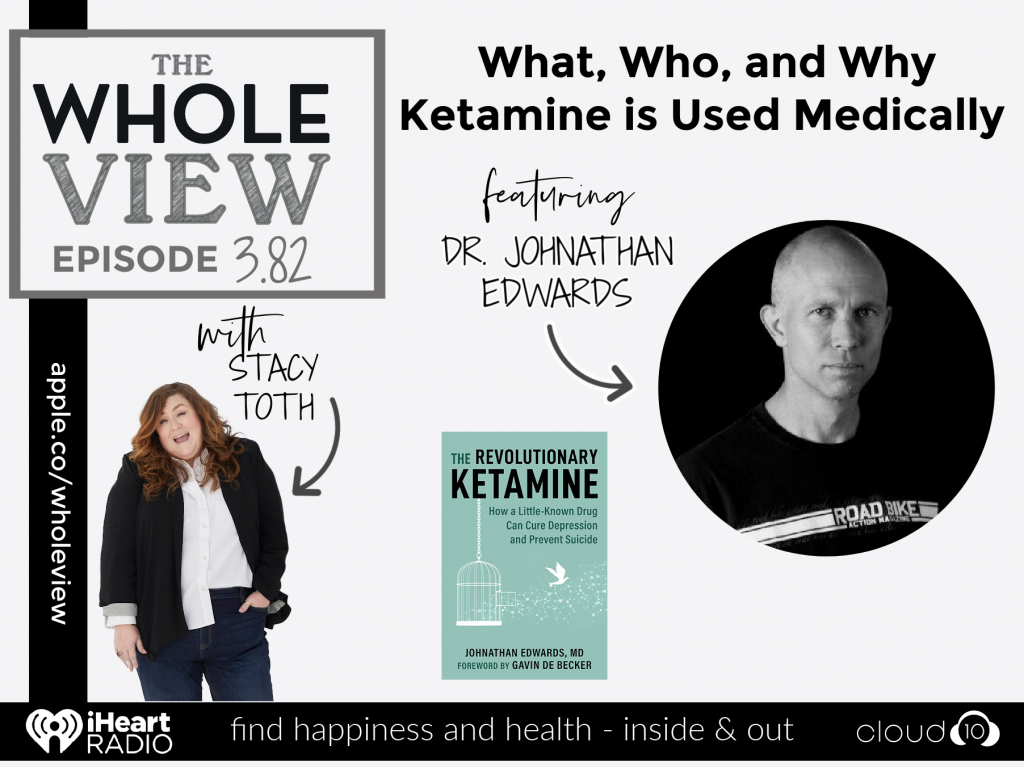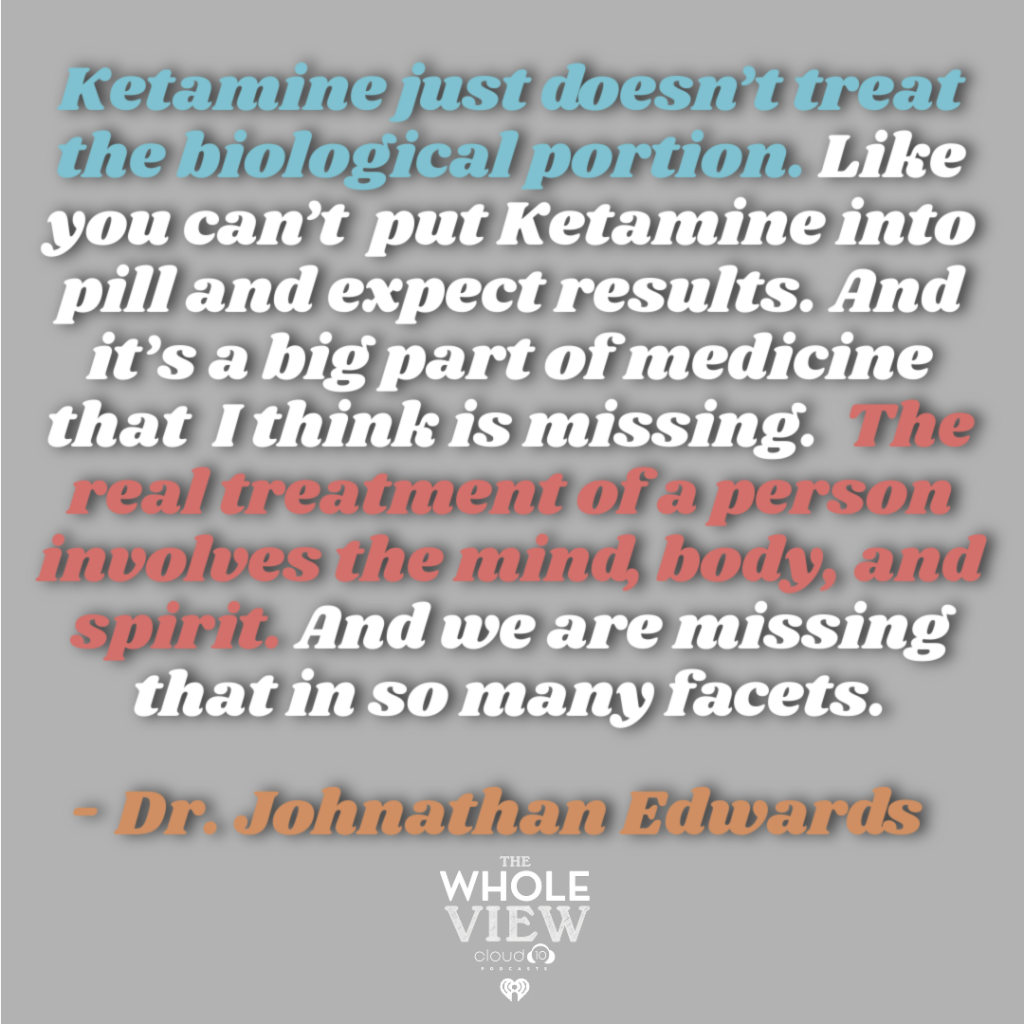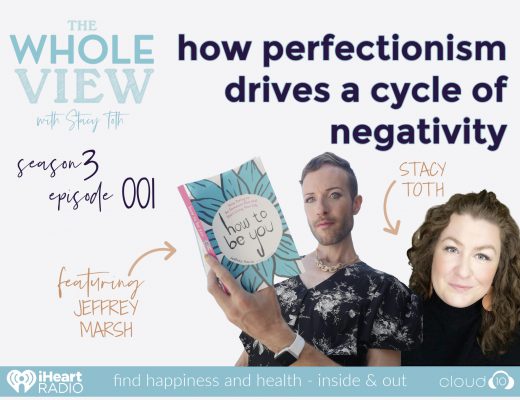Welcome Dr. Johnathan Edwards to The Whole View! Stacy and Dr. Edwards dive into the history of Ketamine and its uses throughout the years. Dr. Edwards helps us understand the mechanisms and benefits of this drug and how using interventions with Ketamine infusions alongside therapy can be a safe and effective treatment for depression and suicidality.
Trigger warning: We will be talking about depression, suicidality, and other mental health conditions for which Ketamine may be a medical solution. If these topics are triggering or inappropriate for little ears, please protect yourself and them accordingly.

Find Dr. Edwards:
Dr. Edwards will be at the SPEAK event in New York on October 18!
If you enjoy the show, please leave a review. Letting people know on iTunes or however you listen that it’s worth their time could change someone’s life!

Key Takeaways
Introductions
- Dr. Jonathan Edwards is a medical doctor specializing in human health and optimization. Furthermore, his medical journey has taken him to France, West Africa, Mexico, and Peru. He provides consultations in English and French.
- After getting a BS in Physiology, Dr. Edwards went to medical school in Eastern Virginia, then he went on to Universities in Reno for Internal Medicine, and to Utah for Physical Medicine and Rehabilitation, where he then went on to be a Research Fellow in Neurology in France. Lastly, he got this degree in Anesthesiology from the University of South Florida.
The Revolutionary Ketamine
History & Uses
- Ketamine has been FDA-approved for decades; it’s the anesthesia of choice for children because of its excellent safety profile. The dose is safe for the treatment of depression as it’s one-tenth the dose that’s been used consistently for anesthesiology. Additionally, the military uses Ketamine to help war veterans recover from PTSD.
- A breif timeline of Ketamine:
- 60s: Synthesized molecule called CI-581
- 70s: FDA approved for medical use; WHO lists Ketamine as an essential medication and is the most used anesthetic in the world.
- 80s: Ketamine’s use as a party drug increases, in powder and capsule form.
- 90s: Government begins to try to control usage; while at the same time it is honed to be used in veterinary medicine as well as for treatment for eating disorders, leading to the discovery of it as a depression medication.
- 2000s: Becomes effective medication used in psychiatry.
- Stacy notes that while there are over 70,000 published articles on Ketamine with highlights on its safety, that Dr. Edwards’ book focuses specifically on Ketamine as a suicide prevention measure, and a means to treat depression:
- 21 million Americans experience major depression and ⅓ have treatment resistant depression.
- 70% of depressed patients responded to a single treatment of subanesthetic dose of Ketamine.
- A 2022 study of 235 suicidal patients aged 14-84 received 6 infusions over 2-3 weeks, and suicidal ideations stopped in as little as 4 hours- demonstrated was rapid, safe, and short-term with persistent benefits.
- So the treatment as an infusion quickly results in antidepressant effects and abates impulsive suicidal thoughts, helping people become “unstuck” from abnormal patterns of brain activity associated with repetitive, negative thoughts.
Benefits
- Functional MRIs have validated the benefits of Ketamine. Ketamine affects various cellular functions, including genes, neurotransmitters, hormones, cytokines, an receptors. Some of Ketamine’s mechanisms may be the increase in glutamate levels, decreasing brain inflammatory molecules, activating proteins like brain-derived neurotrophic factor and inducing neuroplasticity.
- Some benefits broken into 4 effects:
- Produce safe environment and remove fear through the root of psychological trauma
- Anti-addictive – not physical addition so can treat addictions to alcohol or drugs
- Neuroplasticity creating neural pathways
- Spiritual connection or reconnection
- Dr. Edwards notes that if we’re going to use Ketamine as an effective therapy to tackle mental illness, we also need to give people the correct amount of therapy.
- However, there are some patients who report “an unpleasant experience.” Dr. Edwards notes that these infusions are not all the “rosy, Monet-type images” that flow through the mind. It can be very beautiful, but sometimes peoples traumas are just terrifying, no matter which way you look at them. Any psychedelic treatment allows you to look at your traumas in a way you could never look at them or deal with them in what we’ll call a “normal” state of mind. So, he believes that what occurs during a Ketamine treatment is probably what was probably supposed to happen.
Studies, References & Products
- The Revolutionary Ketamine: The Safe Drug That Effectively Treats Depression and Prevents Suicide by Johnathan Edwards, MD
- The Gift of Fear by Gavin de Becker
- The Whole View, Season 3, Episode 77: Pathway to Healing w/ Madeline Popelka
- The Tim Ferriss Show #625: All Things Ketamine, The Most Comprehensive Podcast Episode Ever with Dr. John Krystal
- Autism on Acid: How LSD Helped Me Understand, Navigate, Alter & Appreciate My Autistic Perceptions by Aaron Paul Orsini
Sponsors
- Indeed.com/WHOLEVIEW | Get a $75 sponsored job credit
- Puori.com/wholeview | Use code WHOLEVIEW to get 20% off sitewide
- Beautycounter.com/StacyToth | Go to Realeverything.com/October for special listener deals!
Want more info on our Real Life? Healthy recipes, parenting tips, and general lifestyle stuff goes out in our Real Everything newsletter, join here.
Never want to miss a post, sale, or deal? Join my Healthy Inside & Out e-mail list for more info on non-toxic living and safer skincare!




